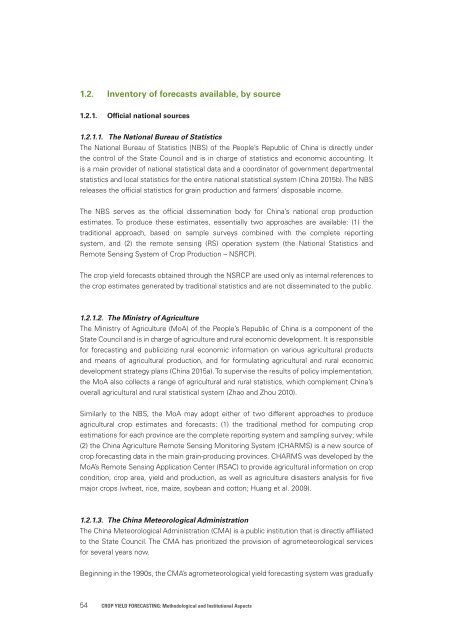Crop Yield Forecasting
1qKZxmS
1qKZxmS
You also want an ePaper? Increase the reach of your titles
YUMPU automatically turns print PDFs into web optimized ePapers that Google loves.
1.2. Inventory of forecasts available, by source<br />
1.2.1. Official national sources<br />
1.2.1.1. The National Bureau of Statistics<br />
The National Bureau of Statistics (NBS) of the People’s Republic of China is directly under<br />
the control of the State Council and is in charge of statistics and economic accounting. It<br />
is a main provider of national statistical data and a coordinator of government departmental<br />
statistics and local statistics for the entire national statistical system (China 2015b). The NBS<br />
releases the official statistics for grain production and farmers’ disposable income.<br />
The NBS serves as the official dissemination body for China’s national crop production<br />
estimates. To produce these estimates, essentially two approaches are available: (1) the<br />
traditional approach, based on sample surveys combined with the complete reporting<br />
system, and (2) the remote sensing (RS) operation system (the National Statistics and<br />
Remote Sensing System of <strong>Crop</strong> Production – NSRCP).<br />
The crop yield forecasts obtained through the NSRCP are used only as internal references to<br />
the crop estimates generated by traditional statistics and are not disseminated to the public.<br />
1.2.1.2. The Ministry of Agriculture<br />
The Ministry of Agriculture (MoA) of the People’s Republic of China is a component of the<br />
State Council and is in charge of agriculture and rural economic development. It is responsible<br />
for forecasting and publicizing rural economic information on various agricultural products<br />
and means of agricultural production, and for formulating agricultural and rural economic<br />
development strategy plans (China 2015a). To supervise the results of policy implementation,<br />
the MoA also collects a range of agricultural and rural statistics, which complement China’s<br />
overall agricultural and rural statistical system (Zhao and Zhou 2010).<br />
Similarly to the NBS, the MoA may adopt either of two different approaches to produce<br />
agricultural crop estimates and forecasts: (1) the traditional method for computing crop<br />
estimations for each province are the complete reporting system and sampling survey; while<br />
(2) the China Agriculture Remote Sensing Monitoring System (CHARMS) is a new source of<br />
crop forecasting data in the main grain-producing provinces. CHARMS was developed by the<br />
MoA’s Remote Sensing Application Center (RSAC) to provide agricultural information on crop<br />
condition, crop area, yield and production, as well as agriculture disasters analysis for five<br />
major crops (wheat, rice, maize, soybean and cotton; Huang et al. 2009).<br />
1.2.1.3. The China Meteorological Administration<br />
The China Meteorological Administration (CMA) is a public institution that is directly affiliated<br />
to the State Council. The CMA has prioritized the provision of agrometeorological services<br />
for several years now.<br />
Beginning in the 1990s, the CMA’s agrometeorological yield forecasting system was gradually<br />
54<br />
<strong>Crop</strong> <strong>Yield</strong> <strong>Forecasting</strong>: Methodological and Institutional Aspects


